Inbound Marketing: How to Pull Customers In and Keep Them Coming Back
Ever wonder why some brands seem to have a steady stream of happy customers while others scramble for every lead? The secret is inbound marketing – a strategy that draws people in with useful content, then guides them toward a purchase without the hard‑sell pressure.
Inbound marketing starts with understanding what your audience actually wants. Instead of bombarding them with ads, you create blog posts, videos, or infographics that answer their questions. When the content is spot on, search engines reward you with higher rankings, and people start finding you naturally.
Why inbound marketing works
First off, it aligns with how people shop today. Most buyers research online before they buy, and they trust information that feels helpful rather than pushy. By offering that help, you become a trusted source, which shortens the time it takes for a prospect to decide.
Second, inbound marketing fuels other channels. Good SEO (search engine optimization) makes your articles rank higher, which feeds more traffic into your email list. A strong email list lets you nurture leads with personalized messages, turning curiosity into conversion.
Third, it’s measurable. Tools can track which blog post got the most clicks, which email opened, and which page led to a sale. That data lets you double down on what works and drop what doesn’t.
Simple steps to launch your inbound strategy
1. Define your buyer personas. Write down who your ideal customer is – their job, challenges, and the language they use. This will shape every piece of content you create.
2. Map the buyer’s journey. Break the journey into three stages: attract, engage, and delight. List the questions a prospect asks at each stage and plan content that answers them.
3. Create evergreen content. Write blog posts that stay relevant for months, like “How to Choose the Right Digital Marketing Budget” or “Top Benefits of Combining Traditional and Digital Marketing.” Those pieces keep pulling traffic long after they’re published.
4. Optimize for SEO. Sprinkle your primary keyword – inbound marketing – in the title, first paragraph, and headings. Add related keywords like “content strategy” and “lead nurturing” naturally throughout.
5. Promote on social channels. Share your articles where your audience hangs out. Short, catchy captions work better than long descriptions.
6. Capture leads. Offer a free checklist or template in exchange for an email address. Simple forms on blog posts work wonders.
7. Nurture with email. Send a welcome series that introduces your brand, provides extra tips, and eventually presents a relevant offer.
8. Analyze and tweak. Every month, look at traffic, bounce rate, and conversion data. If a post isn’t performing, refresh it with new stats or a better headline.
Putting these steps together creates a cycle: good content brings visitors, SEO keeps them coming, email nurtures them, and data tells you what to improve. Over time, you’ll see more qualified leads, higher conversion rates, and a brand that customers trust.
Ready to try inbound marketing? Start by writing one blog post that solves a common problem for your audience. Optimize it, share it, and watch the traffic roll in. You’ll be amazed at how quickly the pieces start fitting together when you focus on giving value first.
- Dustin Chamberlain
- 0
What can I do to my website to improve inbound marketing?
Improving inbound marketing for my website is essential to attract more visitors and increase conversions. To achieve this, I can focus on creating high-quality, valuable content that addresses the needs of my target audience. Additionally, optimizing my website for SEO will help improve its visibility in search engine results. Implementing a strong social media strategy can also boost engagement and drive more traffic to my site. Lastly, utilizing email marketing and lead nurturing campaigns can help turn potential leads into loyal customers.
Read more